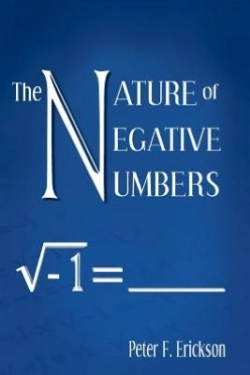
The Nature of Negative Numbers
In his book The Nature of Negative Numbers, Peter Erickson argues that the real number system, although “broadly accepted,” is deficient mainly because of its ambiguities. In algebra the plus symbol (+) can be interpreted in two ways: as a measure of positive quantity and as the binary operation of addition. Likewise, the negation symbol (-) is a measure of negative quantity and the binary operation of subtraction. Erickson tells us why such ambiguity is confusing.
Consider the equation (+6) + (+3) = +9 on the real number line. Here the second + symbol means addition of two positive quantities by starting at the location +6 and moving three units in the positive direction (to the right) to the location +9. Likewise, in the equation (+6) – (+2) = +4 the negation sign means move two units to the left to location +4. However, in the equation (+6) – (– 3) = +9 the negative value 3 negates both the subtraction operation and the quantity itself so the equation changes to (+6) + (+3) = +9. Generations of students were taught that two negatives make a positive. Such sleight of hand is ambiguous.
Erickson will have none of this. In a system he calls the “veritable number system,” positive and negative quantities are divorced from each other. The author states that “it is impossible to combine negative and positive veritable numbers with each other.” In this system operations on positive and negatives are not allowed. Erickson defines analogous operations to real addition and subtraction with different operator symbols (& indicates addition and ~ indicates subtraction, while multiplication and division operators are unchanged). Within this system he can conclude that the square root operation of √-1 = -1 is thus true, making imaginary numbers less magical and filling in the blank on the book’s cover. His enthusiasm is evident in the title of chapter 5: “The Harmony within the Imaginary Number System.”
The majority of the book works to reconcile and integrate the veritable number system with a variety of mathematical topics including the nature of zero, ratios (fractions), absolute values, Cartesian and polar coordinates, and logarithms. The material is complex but the language is precise and the reasoning convincing. Readers must be well-versed in algebra, trigonometry, analytical geometry, number theory, and elementary calculus. An adequate knowledge of these concepts is assumed in order to understand Erickson’s presentation.
Mathematicians may debate the integrity and acceptability of Erickson’s system. For example, in the discussion of the relative placement of zero on a number line, Erickson notes the existence of the three temperature scales: Kelvin, Celsius, and Fahrenheit. He argues that only the Kelvin scale treats zero as absolute and believes that fact “renders both Celsius and Fahrenheit obsolete, and that it should replace them.” Neither this change nor the widespread use of the veritable number system is going to happen anytime soon.
The author’s non-conformist attitude toward accepted number theory allied with a lucid narrative make this book an interesting and thought-provoking read for mathematicians and scientists.
Reviewed by
Thomas H. Brennan
Disclosure: This article is not an endorsement, but a review. The publisher of this book provided free copies of the book and paid a small fee to have their book reviewed by a professional reviewer. Foreword Reviews and Clarion Reviews make no guarantee that the publisher will receive a positive review. Foreword Magazine, Inc. is disclosing this in accordance with the Federal Trade Commission’s 16 CFR, Part 255.
